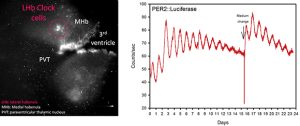
Presentation
 The sleep-wake cycle is one of the most important daily biological rhythms regulated by an internal circadian clock in the hypothalamic suprachiasmatic nucleus (SCN), and modulated by other brain clocks like the habenular nuclei. The sleep-wake rhythm is mainly synchronized to the light-dark cycle. Nowadays, society imposes social and work schedules that can be misaligned from the natural light-dark cycle, and thus drive our activities around the 24h of the day. Furthermore, light exposure at night (light pollution) alters the internal timing system and then the sleep-wake pattern. Thus, a misalignment between external and internal time, affects our physiology and behavior and may lead to serious health consequences.
The sleep-wake cycle is one of the most important daily biological rhythms regulated by an internal circadian clock in the hypothalamic suprachiasmatic nucleus (SCN), and modulated by other brain clocks like the habenular nuclei. The sleep-wake rhythm is mainly synchronized to the light-dark cycle. Nowadays, society imposes social and work schedules that can be misaligned from the natural light-dark cycle, and thus drive our activities around the 24h of the day. Furthermore, light exposure at night (light pollution) alters the internal timing system and then the sleep-wake pattern. Thus, a misalignment between external and internal time, affects our physiology and behavior and may lead to serious health consequences.
Our group interest, particularly, is in the study of the neural and molecular mechanisms implicated in the role of the circadian system and clock genes in reward-related behaviors in physiological and physiopathological conditions (addiction, mood disorders).
- Current research focus in 3 principal aims:
The implication of clock genes and light in the regulation of eating behavior, and the effects of high-caloric eating on the brain circadian system - Characterization of the clock in the lateral habenula for the control of motivated circadian behaviors
- Impact of social jetlag in addicted behaviors: neural and molecular clock mechanisms.
- Dr. Katia Befort (LNCA CNRS, Université de Strasbourg)
- Prof. Samer Hattar (NIMH, USA)
- Dr. Lucas Lecourtier (LNCA CNRS, Université de Strasbourg)
- Prof. Vincent Lelievre (INCI CNRS, Université de Strasbourg)
Mendoza J. Eating Rewards the Gears of the Clock. Trends Endocrinol Metab. 2019 May; 30(5):299-311. doi: 10.1016/j.tem.2019.03.001.
Salaberry NL, Hamm H, Felder-Schmittbuhl MP, Mendoza J. A suprachiasmatic-independent circadian clock(s) in the habenula is affected by Per gene mutations and housing light conditions in mice. Brain Struct Funct. 2019 Jan; 224(1):19-31. doi: 10.1007/s00429-018-1756-4.
Mendoza J. Food intake and addictive-like eating behaviors: Time to think about the circadian clock(s). Neurosci Biobehav Rev. 2018 Jul 7. pii: S0149-7634(18)30115-5. doi: 10.1016/j.neubiorev.2018.07.003.
Itzhacki J, Clesse D, Goumon Y, Van Someren EJ, Mendoza J. Light rescues circadian behavior and brain dopamine abnormalities in diurnal rodents exposed to a winter-like photoperiod. Brain Struct Funct. 2018 Jul;223(6):2641-2652. doi: 10.1007/s00429-018-1655-8.
Salaberry NL, Mateo M, Mendoza J. The Clock Gene Rev-Erbα Regulates Methamphetamine Actions on Circadian Timekeeping in the Mouse Brain. Mol Neurobiol. 2017 Sep; 54(7):5327-5334. doi: 10.1007/s12035-016-0076-z.
Feillet CA, Bainier C, Mateo M, Blancas-Velázquez A, Salaberry NL, Ripperger JA, Albrecht U, Mendoza J. Rev-erbα modulates the hypothalamic orexinergic system to influence pleasurable feeding behaviour in mice. Addict Biol. 2017 Mar; 22(2):411-422. doi: 10.1111/adb.12339.
• Agence Nationale de la Recherche (ANR JCJC AddiClock)
• Fondation pour la Recherche Médicale. Partenariat DANONE-FRM
• The Neuro-Time ERASMUS-Mundus Program











